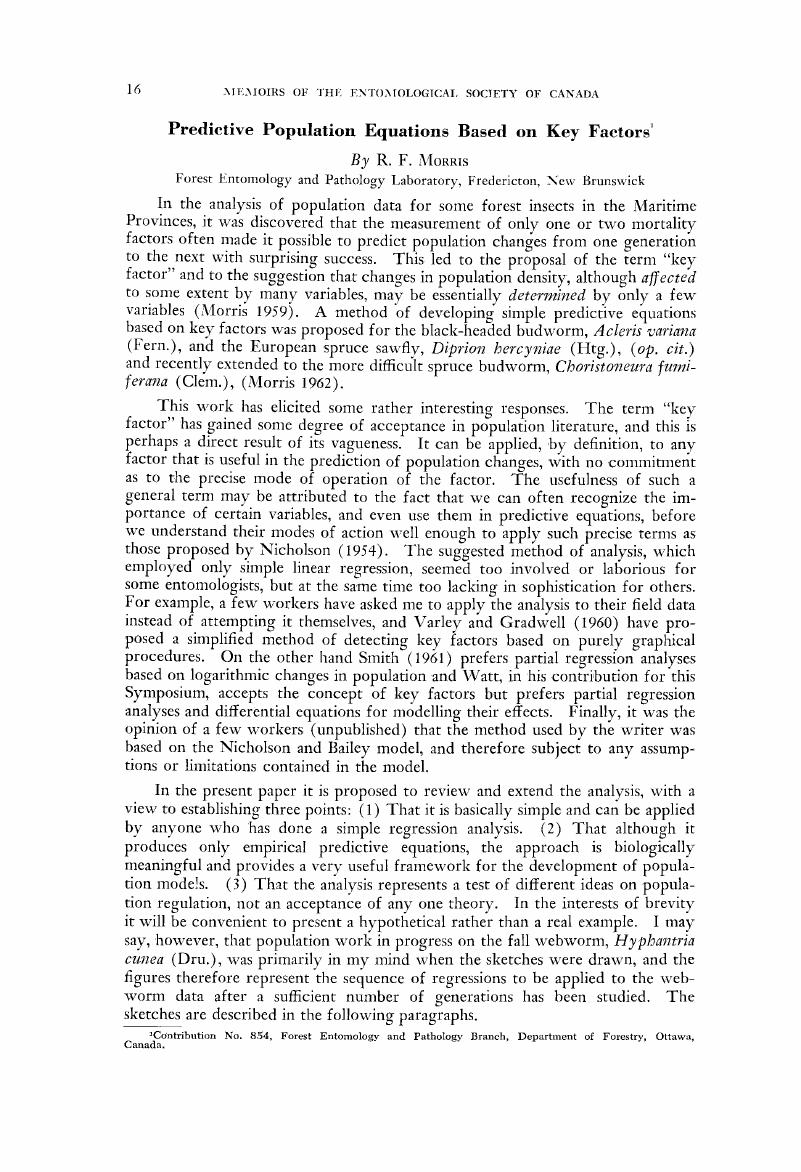Crossref Citations
This article has been cited by the following publications. This list is generated based on data provided by Crossref.
Watt, Kenneth E. F.
1964.
Density Dependence in Population Fluctuations.
The Canadian Entomologist,
Vol. 96,
Issue. 8,
p.
1147.
Watt, K. E. F.
1964.
Comments on Fluctuations of Animal Populations and Measures of Community Stability.
The Canadian Entomologist,
Vol. 96,
Issue. 11,
p.
1434.
Solomon, M.E.
1964.
Advances in Ecological Research Volume 2.
Vol. 2,
Issue. ,
p.
1.
Embree, D. G.
1965.
The Population Dynamics of the Winter Moth in Nova Scotia, 1954–1962.
Memoirs of the Entomological Society of Canada,
Vol. 97,
Issue. S46,
p.
5.
Klomp, H.
1966.
Advances in Ecological Research Volume 3.
Vol. 3,
Issue. ,
p.
207.
White, E. G.
and
Huffaker, C. B.
1969.
Regulatory processes and population cyclicity in laboratory populations of Anagasta Kühniella (Zeller) (Lepidoptera: Phycitidae) II. Parasitism, predation, competition and protective cover.
Population Ecology,
Vol. 11,
Issue. 2,
p.
150.
Itô, Yosiaki
Shibazaki, Atsuhiro
and
Iwahashi, Osamu
1969.
Biology of hyphantria cunea drury (lepidoptera : Arctiidae) in Japan. IX. population dynamics.
Population Ecology,
Vol. 11,
Issue. 2,
p.
211.
Huffaker, C. B.
van de Vrie, M.
and
McMurtry, J. A.
1970.
Ecology of tetranychid mites and their natural enemies: A review: II. Tetranychid populations and their possible control by predators: An evaluation.
Hilgardia,
Vol. 40,
Issue. 11,
p.
391.
Kuno, Eizi
and
Hokyo, Nobuhiko
1970.
Comparative analysis of the population dynamics of rice leafhoppers, Nephotettix cincticepsUhler and Nilaparvata lugensStål, with special reference to natural regulation of their numbers.
Population Ecology,
Vol. 12,
Issue. 2,
p.
154.
Southern, H. N.
1970.
The natural control of a population of Tawny owls (Strix aluco).
Journal of Zoology,
Vol. 162,
Issue. 2,
p.
197.
Kuno, Eizi
1971.
Sampling error as a misleading artifact in “key factor analysis”.
Population Ecology,
Vol. 13,
Issue. 1,
p.
28.
Luck, Robert F.
1971.
AN APPRAISAL OF TWO METHODS OF ANALYZING INSECT LIFE TABLES.
The Canadian Entomologist,
Vol. 103,
Issue. 9,
p.
1261.
Harcourt, D. G.
1971.
POPULATION DYNAMICS OF LEPTINOTARSA DECEMLINEATA (SAY) IN EASTERN ONTARIO: III. MAJOR POPULATION PROCESSES.
The Canadian Entomologist,
Vol. 103,
Issue. 7,
p.
1049.
Varley, G. C.
and
Gradwell, G. R.
1971.
Biological Control.
p.
93.
Varley, G. C.
and
Gradwell, G. R.
1971.
Biological Control.
p.
93.
Itô, Yosiaki
1972.
On the methods for determining density-dependence by means of regression.
Oecologia,
Vol. 10,
Issue. 4,
p.
347.
Kuno, Eizi
1973.
Statistical characteristics of the density‐independent population fluctuation and the evaluation of density‐dependence and regulation in animal populations.
Population Ecology,
Vol. 15,
Issue. 2,
p.
99.
Benson, J. F.
1973.
Some problems of testing for density-dependence in animal populations.
Oecologia,
Vol. 13,
Issue. 2,
p.
183.
Jensen, A.L.
1973.
Statistical analysis of biological data from preoperational-postoperational industrial water quality monitoring.
Water Research,
Vol. 7,
Issue. 9,
p.
1331.
SINCLAIR, A. R. E.
1973.
Regulation, and population models for a tropical ruminant.
African Journal of Ecology,
Vol. 11,
Issue. 3-4,
p.
307.



